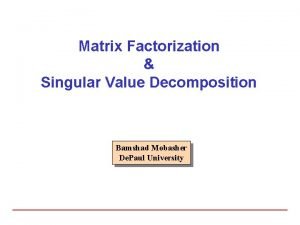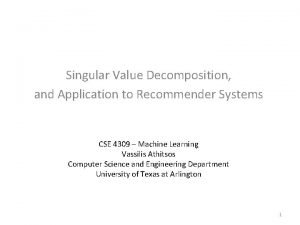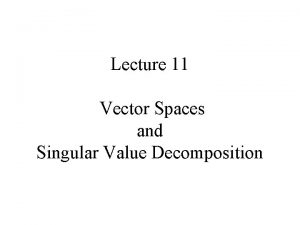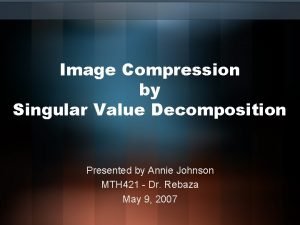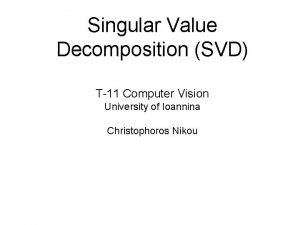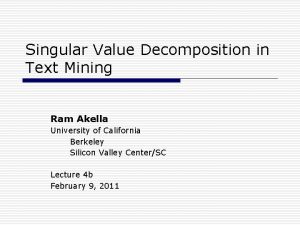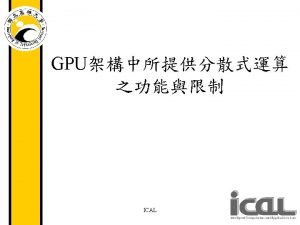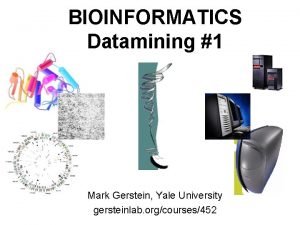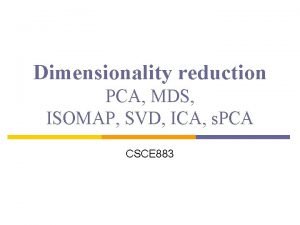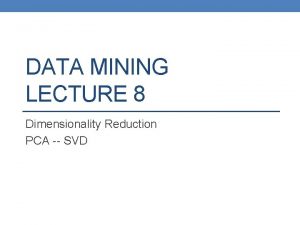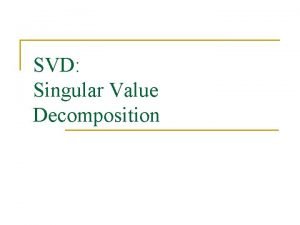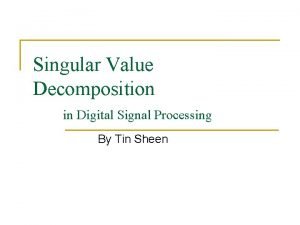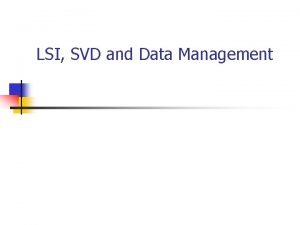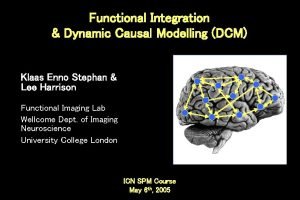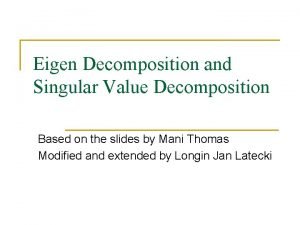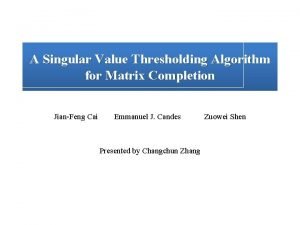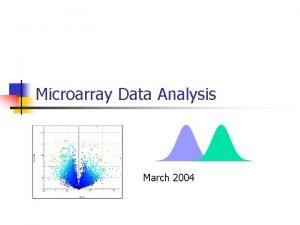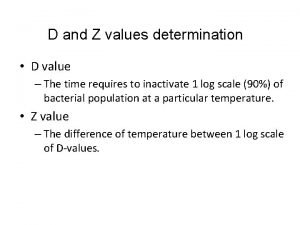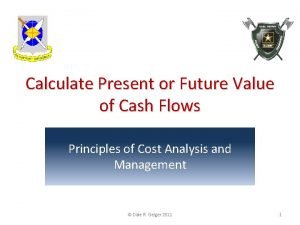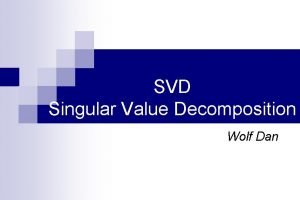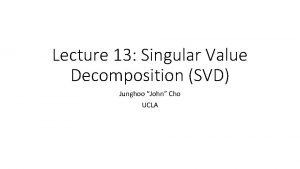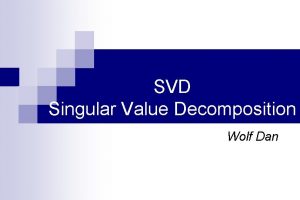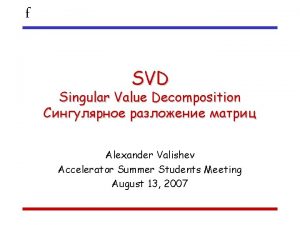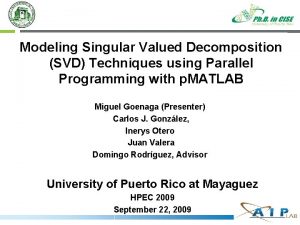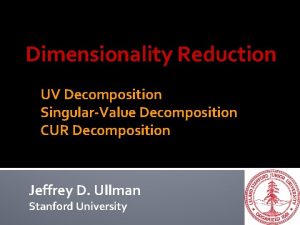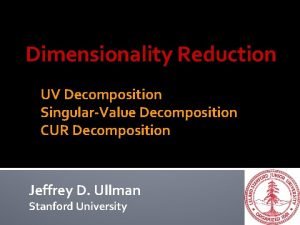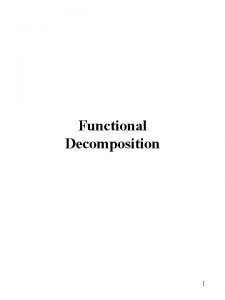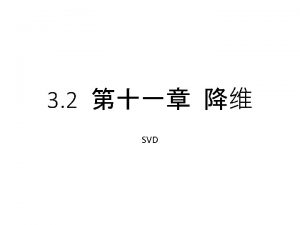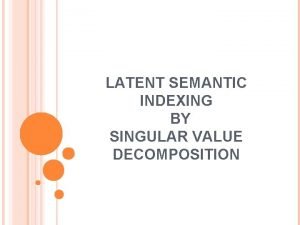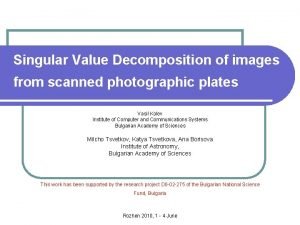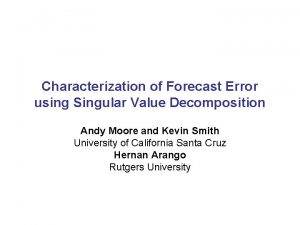SVD Singular Value Decomposition Motivation Assume A full

































- Slides: 33

SVD: Singular Value Decomposition

Motivation Assume A full rank Clearly the winner 2

Ideas Behind SVD n There are many choices of basis in C(AT) and C(A), but we want the orthonormal ones Goal: for Am×n q find orthonormal bases for C(AT) and C(A) orthonormal basis in C(AT) row space column space A Rn Ax=0 orthonormal basis in C(A) Rm ATy=0 3

SVD (2 X 2) I haven’t told you how to find vi’s (p. 9) s: represent the length of images; hence nonnegative 4

SVD 2 x 2 (cont) Another diagonalization using 2 sets of orthogonal bases Compare When A has complete set of e-vectors, we have AS=SL , A=SLS-1 but S in general is not orthogonal When A is symmetric, we have A=QLQT 5

Why are orthonormal bases good? n n ( )-1=( )T Implication: q Matrix inversion q Ax=b 6

More on U and V V: eigenvectors of ATA U: eigenvectors of AAT [Find vi first, then use Avi to find ui This is the key to solve SVD 7

SVD: A=USVT n n n The singular values are the diagonal entries of the S matrix and are arranged in descending order The singular values are always real (nonnegative) numbers If A is real matrix, U and V are also real 8

Example (2 x 2, full rank) STEPS: 1. Find e-vectors of ATA; normalize the basis 2. Compute Avi, get si If si 0, get ui Else find ui from N(AT) 9

SVD Theory n If sj=0, Avj=0 vj is in N(A) q The corresponding uj in N(AT) n n Else, vj in C(AT) q n [UTA=SVT=0] The corresponding uj in C(A) #of nonzero sj = rank 10

Example (2 x 2, rank deficient) Can also be obtained from e -vectors of ATA 11

Example (cont) Bases of N(A) and N(AT) (u 2 and v 2 here) do not contribute the final result. The are computed to make U and V orthogonal. 12

Extend to Amxn Basis of N(A) Basis of N(AT) Dimension Check 13

Extend to Amxn (cont) Summation of r rank-one matrices! Bases of N(A) and N(AT) do not contribute They are useful only for nullspace solutions 14

C(AT) N(A) C(A) 15

16

Summary n n SVD chooses the right basis for the 4 subspaces AV=US q q n n v 1…vr: orthonormal basis in Rn for C(AT) vr+1…vn: N(A) u 1…ur: in Rm C(A) ur+1…um: N(A T) These bases are not only , but also Avi=siui High points of Linear Algebra q Dimension, rank, orthogonality, basis, diagonalization, … 17

SVD Applications n n Using SVD in computation, rather than A, has the advantage of being more robust to numerical error Many applications: q q q n Inverse of matrix A Conditions of matrix Image compression Solve Ax=b for all cases (unique, many, no solutions; least square solutions) rank determination, matrix approximation, … SVD usually found by iterative methods (see Numerical Recipe, Chap. 2) 18

19

SVD and Ax=b (m n) n Check for existence of solution 20

Ax=b (inconsistent) No solution! 21

Ax=b (underdetermined) 22

Pseudo Inverse (Sec 7. 4, p. 395) n The role of A: q n Takes a vector vi from row space to siui in the column space The role of A-1 (if it exists): q Does the opposite: takes a vector ui from column space to row space vi 23

Pseudo Inverse (cont) n n While A-1 may not exist, a matrix that takes ui back to vi/si does exist. It is denoted as A+, the pseudo inverse A+: dimension n by m 24

Pseudo Inverse and Ax=b A panacea for Ax=b n Overdetermined case: find the solution that minimize the error r=|Ax–b|, the least square solution 25

Ex: full rank 26

Ex: over-determined Will show this need not be computed… 27

Over-determined (cont) Same result!! 28

Ex: general case, no solution 29

Matrix Approximation making small s’s to zero and back substitute (see next page for application in image compression) 30

Image Compression n As described in text p. 352 For grey scale images: m n bytes n Only need to store r (m+n+1) n Original 64 64 r = 1, 3, 5, 10, 16 (no perceivable difference afterwards) 31

32

33
 Svd decomposition
Svd decomposition Singular value decomposition for recommendation systems
Singular value decomposition for recommendation systems Singular value decomposition
Singular value decomposition Singular value decomposition
Singular value decomposition Singular value decomposition image compression
Singular value decomposition image compression Features of entrepreneurship
Features of entrepreneurship Apa itu value creation
Apa itu value creation Svd example
Svd example Svd text mining
Svd text mining Cuda svd
Cuda svd Svd data mining
Svd data mining Svd nedir
Svd nedir Svd
Svd Pca svd
Pca svd Svd
Svd Isomap matlab
Isomap matlab Svd
Svd Svd
Svd Full rank
Full rank Svd
Svd Svd
Svd Svd
Svd Svd
Svd Decomposition
Decomposition Pronoun verb agreement
Pronoun verb agreement The expectancy model is developed by -
The expectancy model is developed by - Field theory psychology
Field theory psychology Singular value thresholding
Singular value thresholding Full value contract
Full value contract In the previous lesson i learned that accounting
In the previous lesson i learned that accounting P value formula
P value formula D value and z value
D value and z value Acid value principle
Acid value principle Present value table
Present value table
